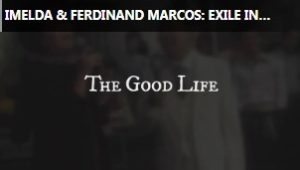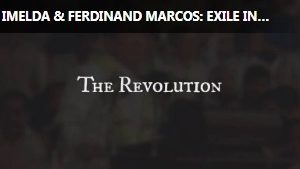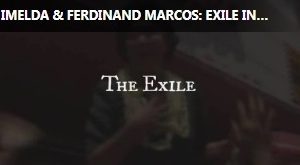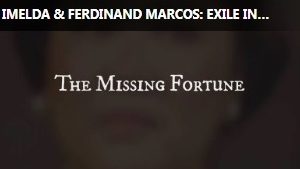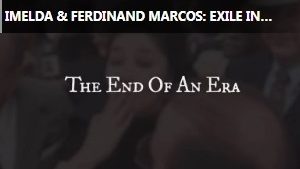Video Sources 0 Views
Imelda & Ferdinand: Exile In Hawaii: 1x4
Chapter IV - The Missing Fortune
HONOLULU, Hawaii (HawaiiNewsNow) – Nearly 30 years since Ferdinand Marcos died in exile in Hawaii, the billions of dollars the family was suspected of siphoning from the Philippines’ treasury is still missing.
The Marcos accumulated their riches in jewels, stock, real estate and art.
The outrageous scope of their pilfered wealth was so great it earned them the Guinness World Record for the greatest robbery of a government.
But the Marcos family has vehemently denied any wrongdoing.
In fact, Imelda Marcos famously claimed that the bulk of her husband’s wealth came from an elusive buried treasure, known as “Yamashita’s gold.”
So, where did all the money go?
When the Marcos’ were exiled to Honolulu in 1986, it was reported that the group carried with them large amounts of cash, gold, valuables, land titles and stocks from the Philippines.
After they landed at Hickam Air Force Base, it wasn’t the family that caught journalist Jim McCoy’s eye, but rather strange boxes.
“I had a very good source in federal law enforcement who I presumed was there. I said anything interesting happen? He told me about the jewelry in the Pampers boxes. Now I remember calling the newsroom and saying do we have video of Pampers boxes coming off the plane?” McCoy said.
He added: “We heard that President Reagan was not happy about the Pampers … because it was kind of like they’re fleeing their home country but they’re bringing all the loot with them.”
Belinda Aquino, an Asian studies professor at the University of Hawaii at Manoa, was an anti-Marcos activist in the 1980s. She informed Manila officials about the loot the Marcos’ allegedly brought.
The head of the Philippine Commission for Good Government then immediately hired a Honolulu attorney to try to impound the goods.
Sherry Broder, a Honolulu attorney, has pursued a decades-long legal battle to recover the money.
“I told my husband, ‘can’t we sue him for human rights abuses?’ My husband was a law professor of international law and this was really his field. And he said, ‘yeah we can,’” Broder said.
However, only a few pieces from the Marcos’ collection have been recovered.
The 1899 artwork by French artist Claude Monet was at the center of one of the fights to recover the funds.
Officials discovered that Vilma Bautista, a confidante and personal secretary of Imelda Marcos, had sold the painting. She got into legal troubles for not paying taxes on the deal.
“She then claimed that Imelda Marcos had given her that painting, of course she must’ve been quite an excellent secretary if she got a $40 million gift,” Broder said.
“So, we immediately got involved in a whole dispute going on about who it belonged to and who it didn’t belong to. In that particular situation, the buyer of the Monet painting settled with us.”
Then there was the jewelry, which is still a point of contention.
Pio Abad, a Filipino artist and London jeweler, recreated the jewels using 3D printed replicas in a Honolulu exhibit that represented a portion of Imelda’s impressive collection.
Each piece includes a caption of what the jewelry’s value could have meant monetarily to Filipinos.
“Among them, an antique Ceylon sapphire and diamond necklace mounted in silver and gold that could provide electricity to approximately 2,252 households in off-grid areas in the Philippines,” Abad said. “A matching set of antique diamonds, sapphire and ruby bracelet, pendant and earrings mounted in silver and gold that is worth the full immunization of 20,000 children, plus 17,600 vaccines to senior citizens and infants.”
As for the real jewels, the Filipino government plans to auction off the collection.
Current Philippine President Rodrigo Duterte, who is reportedly allied with the Marcos famil, approved the sale this year after initially cancelling the auction in 2016.
Copyright 2019 Hawaii News Now. All rights reserved.
 1 - 1Chapter I - The Good Life Nov. 16, 2024
1 - 1Chapter I - The Good Life Nov. 16, 2024 1 - 2Chapter II - The Revolution Nov. 16, 2024
1 - 2Chapter II - The Revolution Nov. 16, 2024 1 - 3Chapter III - The Exile Nov. 16, 2024
1 - 3Chapter III - The Exile Nov. 16, 2024 1 - 4Chapter IV - The Missing Fortune Nov. 16, 2024
1 - 4Chapter IV - The Missing Fortune Nov. 16, 2024 1 - 5Chapter V - The End of an Era - Finale Nov. 16, 2024
1 - 5Chapter V - The End of an Era - Finale Nov. 16, 2024

